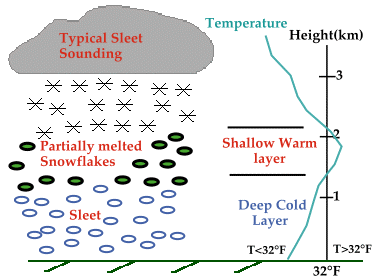| Choice: A |
| Choice: B |
VERSUS
This week on Versus we are challenging you tell apart Sleet and Freezing Rain. This is one of those science lovers pet-peeves, where a lot of people aren't even aware of the difference. Most people can identify rain or snow but ask them if it's sleet or freezing rain and they seem lost. "There's a difference?" you might hear someone say. Well yes there is, and do you know which photo is which?
The answer is Choice: A is sleet and Choice: B is freezing Rain. "Well that's great" your thinking, "But I still can't tell them apart." Ah but you can if you just learn a little bit about temperature gradients. You see the air that is all around us varies in temperature. And we can only experience the air that is directly within our field of contact. So in order to better understand the difference between sleet and freezing rain you need to start thinking about the air around you differently.
 |
| Atmospheric layers & Scale |
As you may already know the air is made up of tiny particles and atoms. These particles all interact with one another taking on and releasing energy. Every time there is an exchange of energy between two particles they give off some from of measurable energy. We refer to this energy as heat. By measuring the amount of energy particles in the air give off we can measure temperature. (Future blog length explanation coming soon)
Now that you understand how we get temperature, lets think about the air around us. The average human can only experience the first 6 feet of the atmosphere by standing outside at sea-level. Our atmosphere as a whole is huge and the first segment (the troposphere) is 30,000ft. Some of you may have noticed how if you climb a tall mountain the air around you gets colder. That is because of the atmosphere changes in temperature as you travel vertically. (See - The Atmosphere)
In order to understand the difference between Sleet and Freezing Rain you must imagine a column of air that stands directly above you. This column will start at the ground you are standing on and extend all the way up to the cloud that is producing the precipitation. For now we are going to ignore winds. (although they do play a role in the development of freezing rain)
 |
| How Sleet Forms |
When Sleet is formed the precipitation starts out as snow. Along the way down through that column of air it hits a warm spot that is above freezing. The snow flakes stay in that spot long enough to partially melt. They are now more like deformed pieces of snow. Then as they continue down the column the air dips below freezing and the half water half snow 'drops' will re-freeze into sleet.
On the ground you can distinguish sleet by a few things. First it bounces when it hits something. You can usually see this effect quite easily. In addition sleet will look like a bunch of pellets on the ground. It does not form a nice layer like snow would, but instead leaves a bumpy looking pile of 'white stuff'.
 |
| How Freezing Rain Forms |
When freezing rain forms it also starts out as snow. But freezing rain doesn't stay as snow quite as long and as it falls down your column of air it quickly hits a much larger pocket of warmer air. This larger pocket of air above the melting point causes the snow to completely melt and form average, run-of-mill raindrops. As the precipitation continues to fall down our column it will only become freezing rain if the 'surface' temperature dips back below freezing. In this case the rain droplets freeze back up, but often not until it contacts the cold surfaces of cars, trees, buildings etc.
On the ground freezing rain will not look as white as snow or sleet, and it often comes down in much smaller pellets or as regular rain. The surfaces that contact the freezing rain will take on a shiny look at first, as the rain is literally freezing onto the surface. Freezing rain doesn't bounce, and over time it leaves a very slippery and very smooth surface of ice behind.
And that folks is the difference between freezing rain and sleet. The differences are not huge, but are distinct and I hope that we now have a few less people confusing the terms after today. Now go fourth and spread the word!
No comments:
Post a Comment